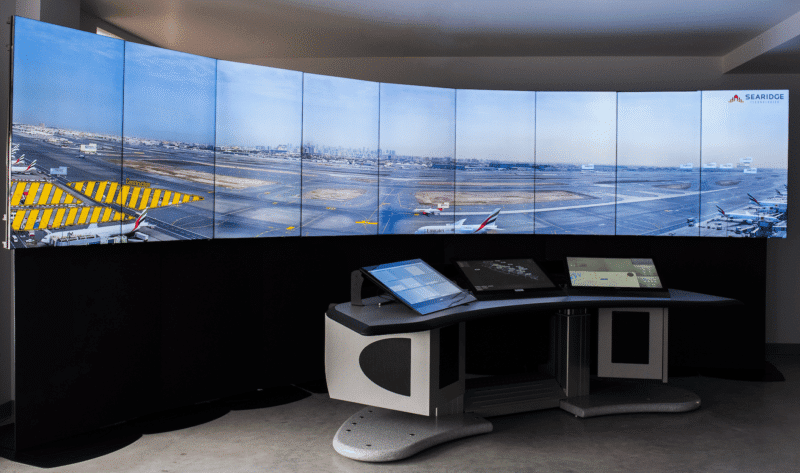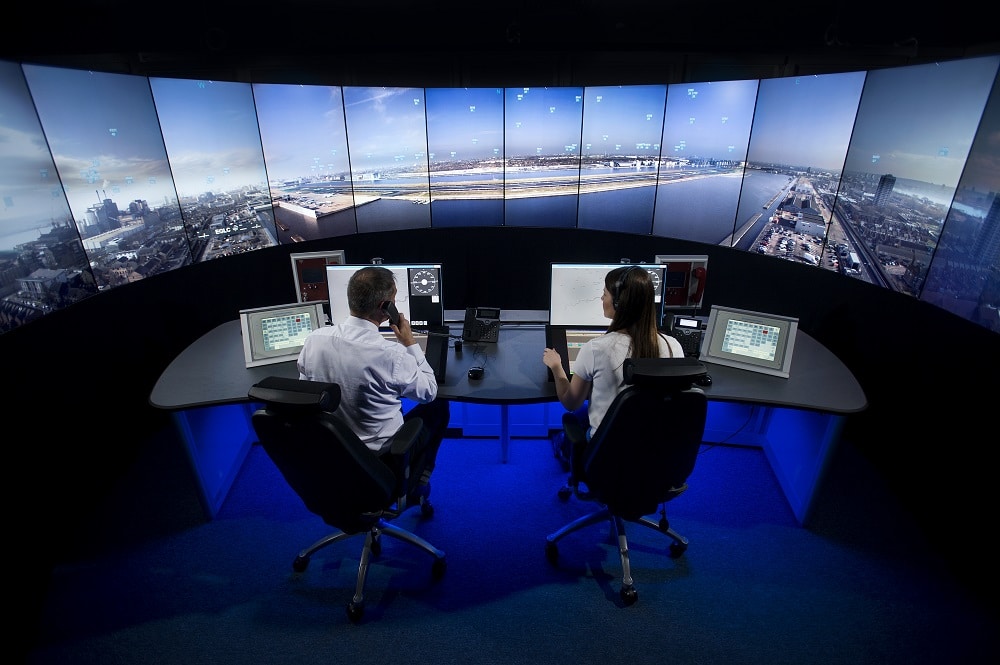Aviation
A London Airport Is Getting an Upgraded Air Traffic Control Tower-80 Miles Away From All the Planes

A London Airport Is Getting an Upgraded Air Traffic Control Tower-80 Miles Away From All the Planes
London’s City Airport is getting its high-tech upgrade in large part due to a lack of space. Instead of a bulky traditional tower that has to house actual humans, the new ATC tower will simply be host to a whole bunch of cameras, with live footage piped to controllers in a building some 18 miles away.
London’s City Airport is getting its high-tech upgrade in large part due to a lack of space. Instead of a bulky traditional tower that has to house actual humans, the new ATC tower will simply be host to a whole bunch of cameras, with live footage piped to controllers in a building some 18 miles away. There are additional benefits beside the saved space, too. The screens at the remote headquarters can compress a 360-degree view into 270 degrees, making it possible monitor more action in a smaller space
The airport is to decommission its traditional tower in 2019, meaning aircraft will be directed from a digital control room in Hampshire. Air traffic controllers will have a 360-degree, high definition view of the airfield, meaning they can monitor planes in more detail than by using the human eye, the airport said.
The technology has already been tested in Australia, Sweden, Norway and Ireland.
Current Situation –
The Tower Building Traditionally every airport has a conventional air traffic control tower, but they don’t come cheap. They cost millions to build and not all parts of the airfield are always visible. In comparison, going digital is more cost effective and offers real operational benefits.
A Digital Alternative
- Controllers use high definition cameras and remote sensing technology to safely and securely manage air traffic from a location away from the airport
- All operational data is transferred via a secure super-fast network to a custom built digital tower operations
room at NATS’ Swanwick air traffic control centre - Wrap around screens give the controllers an unparalleled view of the entire airport
The Technology
- High definition cameras provide a full 360 degree view of the airport
- Laser range finder for measuring distances to pin point accuracy
- Pan, tilt and zoom cameras to view any part of the airfield in unprecedented detail
- Displays enhanced with augmented reality style maps and aircraft data for increased controller awareness.
According NATS blogs Question and Answer.
How safe are digital control towers?
Everything is designed – from the technology to the procedures – with safety in mind and the same will apply for digital towers:
What happens if a camera fails?
In the system we’ll be using at London City Airport from 2019, there are 14 cameras, plus two separate ‘pan tilt zoom’ cameras. If one of the main cameras fails, one of the PTZs can quickly fill the gap until the camera can be swapped out and replaced.
What happens if all the cameras fail?
In the unlikely event that all the cameras fail, or that both of the independent video data feeds drop out, the team will revert to operating under Low Visibility Procedures as they do when in low cloud or fog, using voice communication and radar. This will slow things down, but it’s a normal part of ATC procedures and all very safe.
What about the screens?
There are 15 screens in the facility at Swanwick, meaning that if one of them fails the redundant one can instantly pick up the slack. The controllers can also rejig the order in which the screens display, meaning they will still see the airfield correctly. Then, at the right time, the defunct screen can be swapped out and replaced.
Can it be hacked?
Obviously we can never go into specifics about cyber security, but it is something we take incredibly seriously and keep under constant review. It is not an issue we ignore. What I can say it that the systems undergo extremely vigorous testing and for London City, we will have three entirely private and independent data feeds from the airport to Swanwick – two capable of carrying voice and video data, and the other just voice. 
Wouldn’t it be safer to be at the airport?
This is one I hear quite a lot and I always answer by turning the question around: could it not be safer and more resilient to have your ATC operation offsite? In any case the principle of controlling aircraft from a remote location isn’t new. Our radar controllers at Swanwick and Prestwick centres are looking after aircraft potentially hundreds of miles away and all without ever setting eyes on them.
Liked it ?
Share with your Friends and Family

Aviation
COMAC Unveils Plans for the C929 to Rival Airbus and Boeing

After the success of China’s first C919 aircraft, the country is setting its sights on developing a larger plane. COMAC (Commercial Aircraft Corporation of China) has officially confirmed plans to build a widebody aircraft, marking a significant step in its aircraft lineup.
Traditionally, Airbus and Boeing dominate the widebody aircraft market, with decades of expertise in developing planes and engines capable of carrying heavy payloads. China, which currently relies on imported engines, is now aiming to challenge these giants with its own widebody jet, the C929, designed to compete with the Airbus A350 and Boeing 777.
American Airlines Is Looking for Flight Attendants: Apply Now
The C929 will be China’s first independently developed long-range widebody aircraft. It adheres to international airworthiness standards and boasts independent intellectual property rights. The baseline version is designed to seat 280 passengers and offers a range of 12,000 kilometers, catering to global demand for both regional and international air travel.
Russia, which also needs reliable narrowbody and widebody aircraft, could become a key customer for the C929. Additionally, China plans to target the broader Asian market as it continues to expand its aviation capabilities.
Close Call at Heathrow: BA Flight Narrowly Escapes Drone Collision
China’s aviation progress includes the ARJ21 (now called C909), a regional jet with 100 seats for shorter routes, and the C919, a narrowbody jet with 180 seats designed to rival the Boeing 737 MAX and Airbus A320. Both models have found increasing demand in the domestic market.
At China’s largest air show in Zhuhai, COMAC announced that Air China will be the launch customer for the C929 widebody jet, though details about order size and delivery timelines were not disclosed.
Other major deals announced by COMAC include:
- Hainan Airlines: Firm orders for 60 C919 and 40 C909 regional jets.
- Colorful Guizhou Airlines: 30 C909 jets, with 20 firm orders and 10 provisional agreements.
The C929, renamed from the CR929 after Russia withdrew from the joint development project in 2023, is expected to carry 280–400 passengers with a range of 12,000 kilometers, competing directly with Boeing’s 787 Dreamliner.
According to COMAC’s deputy general manager, Tong Yu, the first fuselage section of the C929 is expected by September 2027, with prototype test flights anticipated soon after.
-

 Aviation2 months ago
Aviation2 months agoMicrosoft Flight Simulator Raises $3 Million to Bring Back the An-225 Mriya
-

 Airlines2 months ago
Airlines2 months agoQantas Engineers Stage Walkout Over Cost of Living Concerns
-

 Airlines2 months ago
Airlines2 months agoQatar Citizens Can Travel to the United States Without a Visa
-

 Aviation2 months ago
Aviation2 months agoQatar Airways bans these new Electronic Devices on plane
-

 Airlines2 months ago
Airlines2 months agoJapan Airlines Rolls Out Free Domestic Flights to International Passengers
-

 Defence2 months ago
Defence2 months agoWhich Country Has the Largest Fleet of Fighter Aircraft?
-

 Airport2 months ago
Airport2 months agoWestern Sydney Airport Welcomes Its First Plane After 6 Years of construction
-

 Travel2 months ago
Travel2 months agoQatar Airways Launches Four Additional Flights from Amsterdam










